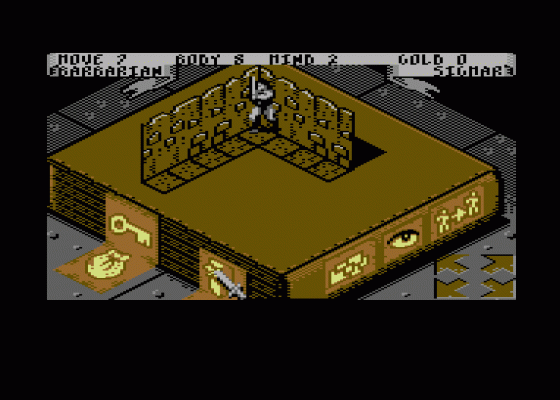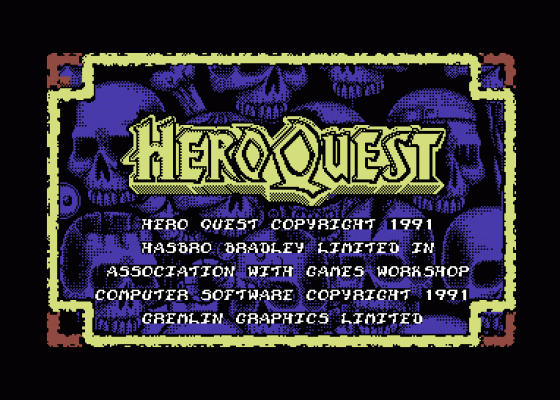Hero Quest
A huge success as a board game, Hero Quest has taken Gremlin's mages eight months to pack into the C64, stuffing the spirit of the evil Morcar into every single copy to provide a diabolical opponent for you! Stuart Wynne straps on his broadsword to go adventurin' once more.
Hero Quest comes with your standard epic clash of 'good and evil'-type scenario. The incredibly evil warlord Morcar has retreated to a labyrinthine castle where he plots his return to power. It's up to four (all male) heroes to complete fourteen different quests and defeat the evil mage...
After a few goes of the board game, Hero Quest's success isn't too surprising. First of all, there's the attractive presentation; high quality playing cards; an attractive board and nicely detailed playing pieces (ideal for painting).

Secondly, there's the violent, magical atmosphere of all the hugely successful D&D RPG games but thirdly, and most importantly, the rules are really very simple. There's none of the complex calculations or open-ended rules which make most RPGs so difficult to master. In Hero Quest, players move according to the roll of a die while interaction is limited to fighting, searching and casting simplistic spells.
The only drawbacks are that you need a player to be Morcar, controlling the evil forces and setting up the furniture, traps etc in each room. The computer version thankfully eliminates all this hassle but obviously the C64's graphics can't recreate the high quality printing of the board game's pieces. In fact, the four characters have now been turned into grey, rather blocky figures.
At the start of the game you assemble your team of four characters - a Wizard, Elf, Barbarian and Dwarf - which can be named, all saved between scenarios. These all have their own characteristics: for example, the barbarian and dwarf can't cast spells, while the wizard can't use some weapons. You can choose to attempt any of fourteen scenarios, thankfully there's a couple of easy levels where you can earn cash to buy weapons and spells for the toughie ones.

When your quest begins, you're confronted with a fairly restricted isometric 3D view centred on one of the characters. You can also access a simplistic map which shows an overhead view of the play area. The floor is divided into squares just like the board game and by clicking on the control panel's four arrows, you can move the character around, up to the maximum number of moves rolled with the die. Actions such as fighting, searching and casting a spell can either be made before or after movement - you can't move, attack and move again.
Combat is similarly artificial - unless you buy a spear, you can't attack from diagonals, and there's two distinct phases: attack and defend. During your turn, you can attack, where you rely on the die throw and your own strength, weapon etc to overcome the set defensive capabilities of your opponent plus his own defensive die roll. Instead of attacking, you may choose instead to search - wise when otherwise invisible hazards include pits, falling blocks and spear traps. There are even traps in treasure chests which, when sprung, immobilize a player for the rest of his turn - if they don't simply kill him.
Another possible action is casting a spell, there are twelve of these with a wide variety of effects from immobilizing a demon to healing a player to enabling someone to move through walls!
After you've made your movement/action for a character you go to the next character in your team. A nice aspect of the game is the speed with which it flicks between characters, making it a lot more natural to control a whole team - you don't need to move around the table consulting charts and inventories for each character. Nevertheless you can still easily play with four people, each controlling their own character.
Once all the characters have made their turns, Morcar can move all his various forces orcs, goblins, etc. Basically this means chasing you into corners where you can be hacked to pieces. The fourteen different scenarios feature some nice storylines, but essentially it's a matter of sneaking around, discovering where the essential objects are and
Second Opinion
The board game was a real social event and the fun to be had interacting with other players is inevitably (and sadly) missed: on computer the game only really works as a one-player bash.
Even so, I found its simplicity and user-friendly approach made for a compulsive game - carrying items through from one quest to another makes the game an on-going mega-quest.
Even with next to no graphic variety between levels, it's still addictive stuff with an element of tension that works better on computer. Simple but fun.
Verdict
Presentation 77%
Icon-control system works well, adventures take long enough that multi-loading them isn't too much hassle, option to save/load characters and informative instruction manual.
Graphics 67%
Flick-screen isometric 3D is rather distinctive with a slight pause between screens. Individual characters are rather blocky and animation is limited.
Sound 48%
An atmospheric tune provides an involving soundtrack.
Hookability 79%
Rules are easily grasped while early levels provide a reassuringly low difficulty level.
Lastability 70%
Fourteen scenarios provide a largish overall challenge, it's not incredibly difficult or varied but scenario disks are almost inevitable.
Overall 75%
A good conversion of an enjoyable board game.


 1st July 1991
1st July 1991

